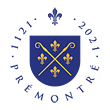Strahov Library collections
CONCISE HISTORY OF THE MONASTIC LIBRARY
The Royal Canonry of Premonstratensians at Strahov, which the Strahov Library is an integral part of, was founded in 1143 by Bishop of Olomouc, Jindoich Zdík, with support from the Prague bishops Jan and Ota, Prince (and later King) of Bohemia Vladislav and his wife Gertrude. The first community of canons regular came from the Rhineland monastery of Steinfeld. Although there are several Latin codices from the oldest collection of the library, we cannot say for sure that the library has enjoyed conscious continual development. What we can say is that the origin of the library collection goes back to the foundation of the abbey. Over the centuries, the abbey has suffered several disasters which have interrupted its smooth evolution. The buildings (evidently wooden) destroyed in the fire of 1258 were replaced by a Romanesque structure which went on to become an integral feature of the Prague skyline. The abbey was plundered in 1278 and 1306 by foreign armies, and in 1420 by Hussite radicals from several towns making up Prague. The abbey was then abandoned during the Hussite Wars. 150 years later, when the abbey was struggling to exist, Jan Lohel (later to become Archbishop of Prague) was elected the new abbot (1586-1612), and reconstructed the abbey as well as the former level of education. In 1627, Lohel's successor Kašpar Questenberg translated the relics of the Order's founder, St Norbert, from Magdeburg to Strahov. St Norbert became one of Bohemian patron saints, and Strahov consequently earned itself a special place among Premonstratensian order houses.
The efforts of Abbot Questenberg and his successors to build a library were thwarted by the invasion of General Konigsmark's Swedish forces in 1648, which took most collections of books with them to Scandinavia.
The books collected after the Peace of Westphalia were given a dignified place of storage after 1679 in the newly constructed library hall, now known as the Theological Hall. The Library Rules were also issued around this time. Because of extensive acquisitions in the second half of the 17th century and throughout the 18th century, the expanding library book collections required another hall (the Philosophical Hall) by the end of the 18th century. At this time, the abbey became a haven of the Czech National Revival, represented there by the librarian G J Dlabae. The latter half of the 19th century and the first half of the 20th century were mainly devoted to the cataloguing of the library's book collections. After 1950, when monastic orders and congregations were forbidden in Czechoslovakia, their members executed, interned, and imprisoned, and their property confiscated, the Strahov Library was incorporated into the newly established Museum of National Literature, and the monastic archives, music collection, picture gallery, and exhibits were dispersed to other state institutions. Soon after 1989, following the collapse of Communism in Czechoslovakia, the buildings and other confiscated property, including the library, were returned (in some cases they are still in the process of being returned) to the Strahov Premonstratensians in a programme to rectify some of the material injustice perpetrated by the Communists. The Strahov library book collections contain approximately 200,000 volumes, estimated to hold 260,000 works. The books are stored in the two halls and in adjacent depositories. Many of the works are old prints printed between 1501 and 1800. The library's incunabula (firstprints) (over 1,500 volumes) and manuscripts (approximately 3,000 sheaves) are also valuable and are stored in a special treasury room.

